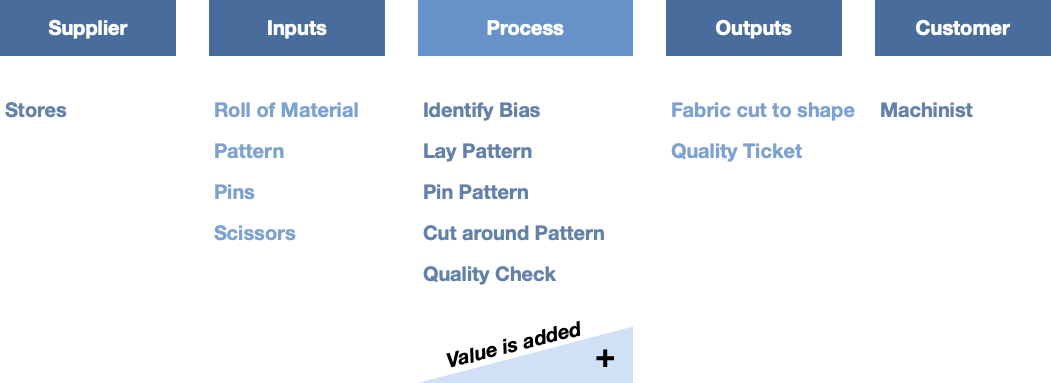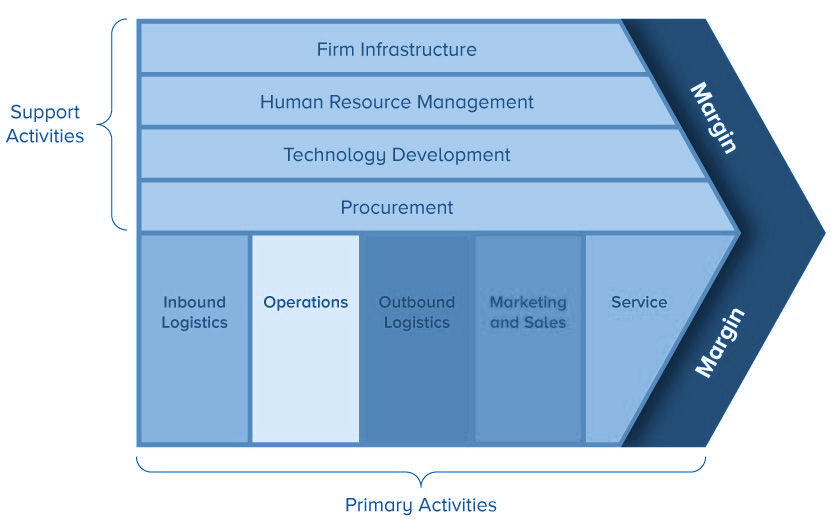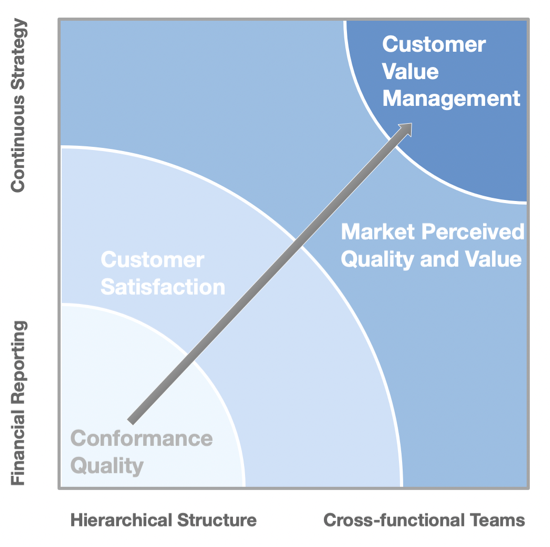Arguably, the purpose of every business is to create value for its customers. The trick is to create and deliver value in an efficient enough way that it will generate profit after cost.
There are many different learned theories on what defines 'value' and how value is created. For simplicity we'll state that value is created through work.
In very general terms we might assert that there are industrial methods of work, those which require physical application, and knowledge methods of work, those which are creative or intellectual. There are also sisyphean tasks like manually updating currency exchange rates or resetting User passwords every day, which, arguably, don't create any lasting value.
Creating value by performing an activity
At micro and macro level whenever we take an input, undertake a task and produce an output, then that very act is the addition of value to what existed before.
For example, consider a factory making garments. The act of receiving a roll of material from stores and cutting it to shape before passing the fabric to a machinist, is a value-adding activity.
When the material in a roll is received from the Stores, it has no obvious purpose when it exists in that state. The value added by the Cutter is that it is transformed, by careful regard to the bias of the grain when laying the pattern, and equal skill in following the pattern and making clean cuts. Once quality checked, the fabric is passed onto the Machinist's workstation.
The 'SIPOC' graphic below brings this to life:

Each person in a company is adding incremental value as they perform their activities as part of the internal value chain. Each step in the value chain has a 'SIPOC' similar to the one above.
At the beginning of the internal value chain are the external suppliers (those who provide the raw materials) and at the other end are the external customers (those who purchase the products). A very generalised view of all business processes is set out in Porter's model, below, which shows each contribution to creating value for customers.

In our example, the material is spun offsite (as part of the Supply Chain), arrives at the factory and through successive steps in Inbound Logistics enters the Warehouse (Stores). The Cutter is part of Operations, as is the Machinist. When the garment is finished it is folded and packaged, then handed to Outbound Logistics to follow their successive steps from shipment to Market, where it is sold - to customers who are nominally to the right of the graphic.
Corporate services enable the primary purpose of the organisation by providing their discrete support activities.
The idea is to create and deliver value in an efficient enough way that it will generate profit after cost - the Margin.
Business process mapping is a useful method of understanding what activities are performed throughout the internal value chain. Once the procedures are captured it then becomes easier to see gaps, inefficiencies and waste, and to remediate them.
Typically the 'Process' part of the 'SIPOC' (as in the example above) is at Level 4 in a Value Stream Process Decomposition table (as below), and the Steps within it are at Level 5.

Levels 3 to 5 are the responsibility of a Process Manager, typically a Team Leader in an organisation. Levels 4 & 5 set out what an individual worker performs. It is good practice for these workers to document what they do as Standard Operating Procedures (SOPs), which are then verified by their Team Leader as accurately and completely representing the work that they actually do.
The value of having a Value Stream Process Decomposition is that it is a framework within which all of the SOPs link together and map into the top-down end-to-end processes. This framework may also be known as a Process Taxonomy.
Levels 0 & 1 reflect the strategic position of the company, and will evolve as the company innovates and responds to changes in the market, consumer preference and technology evolution.
We've discussed how value is created by performing an activity, and how those activities can be linked together as part of an internal value chain. Now we need to realise that creating value by producing a commoditised product is not necessarily a path to riches.
Commodity and Markets
Do your customers have other options other than buying your product or service? Is what you produce meaningfully distinct from your competitors? What is it that will make a potential customer buy your offering rather than buy from another company?
Every business is successful to the extent that it offers something that others cannot offer.
In an ideal world, for enduring success, the value that a business delivers to its customers should not be easily replicable. If not, then some other undifferentiated or unrecognised competitor will do so.
This is one of the great challenges of business life. You've worked out what you need to do and how to do it. You have your internal value chain all nicely set up, then - Bam! - markets move, technology evolves and customer preference changes.
A product or service that provides value and utility to customers, and which generates revenue starts to dry out.
Similarly, the internal value chain is often rendered irrelevant in hierarchically-structured organisations when they don't recognise the customer-centric asymmetric competition which is providing value to their customers, and eating their lunch.
All of a sudden, the sustainable value that you thought you had created doesn't seem to be delivering the sales that you expected. The difference between the size (created value) of your business and its profitability (captured value), the sum of all of the products and services that you've sold, is no longer constant.
Captured value creation is more than calculating the optimal price customers will pay when the costs of sale are taken into account. And it’s more than simply increasing productivity or reducing costs. It’s about delivering something completely new, or a compelling improvement to an existing product or service, which then attracts incremental customer revenue streams.
This distinction is important because it underpins that captured value is determined entirely by your customers – not by your company.
Competitive Advantage
The ability to deliver value is rarely sustainable in business, because markets change, consumer preference varies and technology evolves. And yet corporate strategy is often based on a presiding idea: that sustainable competitive advantage is the main goal.
This presumption of trading equilibrium creates the wrong behaviours in leaders. Evolution in the marketplace, consumer behaviour or technology is often ignored, with a dismissal of the possible negative effect on their business.
Competitive advantage exists where a company provides greater value in its market than its competitors. Such an advantage can only be sustained when the company is organised for business agility - an ability to respond to the different factors which evolve.
Competitive advantage may be created by proprietary assets (unique tooling, trade secrets or patents), network effects, scarcity of resource or access to key resource, or the ability to produce products at a lower cost than everyone else.
More pertinently perhaps, there are actions which may be taken by every company not blessed with that type of embedded advantage: the pivot to being a cross-functional, customer-centric organisation, thorough and deep employee engagement, and a brand relationship with customers that builds trust and loyalty.
It is these actions which will allow the value that your company delivers to be renewed and extended in harmony with the ebb and flow of commerce over the years.
How to measure value
Value as a function of work has evolved over the history of mankind. From hunting, growing, crafting, selling, mechanising, industrialising, servicing through to thinking and computerising, every age has had a perceived benefit and an experienced benefit attached to the goods and services it produced.
Is there a uniform measure of value across the many different ways and different processes that value is created?
Function, Quality and Price are the three most quoted views on what constitutes value in a product or service. Let's discuss each.
Function and Quality
Way back, one of the most common factors of perceived value was the function and quality of the product. Did it meet a need? In many cases, although the product had the expected features, the quality was poor. But the product still sold, in some part due to a lack of competition and in another part a nationalistic pride in buying what your home country produced. Over time, buying a product that had become conformant to a basic standard of quality became normal, and, similarly, professional and trade services began to be performed to repeatable standards.
Companies realised the need to think beyond the product and that their goal was to create happy customers. So, they began talking to customers more, and asking them if they were satisfied on a range of factors. Customer satisfaction became a new measure. Improving conformance to technical standards or market norms was essential, but only as part of the larger process of making customers happy.
Many companies have a budget line set aside for research about their customers and their markets, but this doesn't always give clarity on why they win or lose customers.
There are three challenges here: firstly, many of the customers surveyed will rank a product or service as good or excellent, but then stop purchasing; secondly, the questions are not asked of someone who is buying the competitor's product; thirdly, surveys usually don't measure the product's performance relative to competitors' products.
If your product's performance is improving, your customers will probably score it reasonably well. But if your competitors are improving their products faster, it doesn't take much for your customers to switch allegiance.
Focusing on market-perceived quality versus all competitors is essential to make true strategic thinking possible.
All competition is key here. As mentioned earlier many hierarchically structured organisations are not aware of asymmetric competition.
Once a company has understood the need for regular market-perceived quality activity, and is regularly doing so, then bringing the outcome of that work into the strategy and operational planning process is when customer value management begins.

Customer Value Management is a measure of a company’s customers’ view of the perceived value for money delivered relative to that of their competitors’ customers. It works by directly measuring the drivers of purchasing behaviour and the impact these have upon delivering KPIs such as market share, profit and loss, recommendation, share of wallet, ROI and so on.
The perception of a product or service’s value in the market place can be measured through surveys which ask customers a series of predefined questions. These questions are also asked of the competitors’ customers to establish the equivalent value for competitors’ offers.
Perceived Value = Perceived Benefits / Cost
To drive change, a business must manage the elements which drive the market place’s perception of value, namely quality received for price paid, where quality is often equated to the utility or personal benefit to the individual making the purchase.
Value can be improved by increasing relative perceived quality or by reducing relative perceived price.
Price
Revenue
The most often cited reference to value created is of the revenue that it generates. If it's making money then that's all that matters, right? Yes, up to a point. If someone is willing to pay for the product or service, then the internal value chain process has created something worthwhile. But revenue is not profit. Companies that create value without creating a profit don't do so for long.
Some companies have huge turnovers, creating a lot of value for their customers, but the various costs of production and sale result in a very small profit. Think airlines or hotel room booking services. Other companies - think digital services or construction contractors or legal firms - create less value but capture much more.
A better reference to revenue as a measure is that the value created cannot be less than the revenue it produces. If that sounds obvious, then read on.
Customer surplus
If value is aligned with the ability to meet customers’ needs, then how do customers judge the extent to which an existing product meets their needs, or whether a new product on the market would better do so?
Economists cite utility theory and the notion of marginal utility in their definition of value - that customers spend their budget so as to maximize the satisfaction they get from products or the outcome they get from services.
Total utility refers to possession of a commodity and the satisfaction gained in doing so. Marginal utility refers to the satisfaction that people receive from possessing one extra unit of a good or the satisfaction lost by giving up one unit.
For example, total utility is the pleasure of buying a piping hot pizza when you are hungry. The marginal utility of a third slice of pizza is the change in satisfaction one gets when eating that slice instead of stopping at two. This third slice was made possible because of a decision to buy a larger pizza to share amongst three friends.
In simple terms, people spend their money on what they expect will give them most satisfaction.
How do potential customers develop their expectations, how do they judge the utility they are going to get, and therefore the value of a product or service?
Judgements are made in advance of purchase, so potential customers have to make inferences about the goods, their needs, unique experiences, wants, wishes and expectations. In other words, customers valuation of a product is based on the perceptions of what holistic need it will satisfy.
Value may be further defined as use value + exchange value.
Use value refers to the specific qualities of the product as perceived by a customer, for example the fuel-economy of a car, the food-miles that breakfast raspberries have travelled, or the likely deliciousness of our example pizza. Judgements are those of an individual consumer, and are subjective. Exchange value refers to price. It is the amount paid when the product or service is exchanged between creator and purchaser.
Use value perception applies to all purchases, not just those of final consumers.
The same type of subjective judgement is made by a manager when procuring raw materials and machines from the supply chain, as by an individual when buying a bottle of wine or a TV streaming service. However, it is helpful if the manager has sufficient knowledge of how the company competes, so that what they procure positively contributes to profitability.
Perceived use value can be translated as the price the customer is prepared to pay for the product if there is a single source of supply. In most circumstances, the price actually paid is less that than the total monetary value ascribed to the product or service by the customer.
The difference is the customer surplus, the price plus the value for money.
Purchasers nearly always choose the product or service that offers them the largest customer surplus, and it must give them more surplus than competitor offerings. We all want to feel that we have got value for money.
In our example, the pizza was purchased from a particular restaurant because the perceived use value was the highest available when compared to the exchange value (the cost) at competitor pizza parlours.
This customer surplus is key to perceived customer value, and is one of the main objectives and benefits of becoming a customer-centric organisation. This is what happens when company purpose – its fundamental reason for existing – is embedded in a business.
The customer experience is the true value created
Companies succeed by providing superior customer value, and that value is a combination of the basic utility of the product or service, plus a customer surplus which itself is the result of the way that a company connects with its intended audience.
Assuming that function, quality and price are all acceptable then it is the whole customer experience which determines a sale.
This holistic customer experience starts with an actioned company purpose. A transparent, collaborative and meaningful working environment, and a sense of involvement in a greater societal benefit is a powerful way of engaging employees, and engaged employees build the brand that connects with customers, inspires trust and keeps the company relevant, so that customers repeat their purchases.
Throughout, trust, truth and honesty are important, as are branding and relationships, and sincerity and consistency, plus service and communication.
Your products will become differentiated in ways that are valued by the customer as the customer surplus grows, mitigating any need to cut the price.
If you want to understand the value which customers perceive in your company's products or services, then you'll want to work on customer journey mapping, customer value analysis and in tracking both financial performance and customer value performance.
